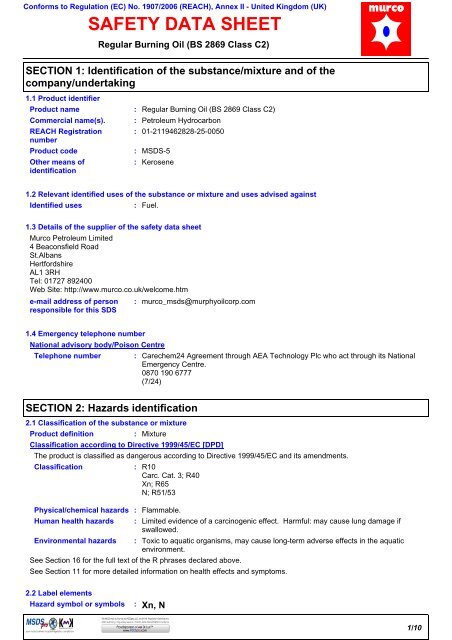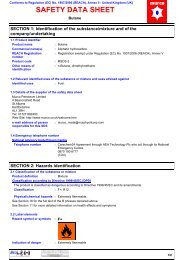Low Sulphur Regular Burning Oil â BS 2869 ... - Murco Petroleum
Low Sulphur Regular Burning Oil â BS 2869 ... - Murco Petroleum
Low Sulphur Regular Burning Oil â BS 2869 ... - Murco Petroleum
You also want an ePaper? Increase the reach of your titles
YUMPU automatically turns print PDFs into web optimized ePapers that Google loves.
Conforms to Regulation (EC) No. 1907/2006 (REACH), Annex II - United Kingdom (UK)<br />
SAFETY DATA SHEET<br />
<strong>Regular</strong> <strong>Burning</strong> <strong>Oil</strong> (<strong>BS</strong> <strong>2869</strong> Class C2)<br />
SECTION 1: Identification of the substance/mixture and of the<br />
company/undertaking<br />
1.1 Product identifier<br />
Product name<br />
Commercial name(s).<br />
REACH Registration<br />
number<br />
Product code<br />
Other means of<br />
identification<br />
:<br />
:<br />
<strong>Regular</strong> <strong>Burning</strong> <strong>Oil</strong> (<strong>BS</strong> <strong>2869</strong> Class C2)<br />
: <strong>Petroleum</strong> Hydrocarbon<br />
: 01-2119462828-25-0050<br />
: MSDS-5<br />
Kerosene<br />
1.2 Relevant identified uses of the substance or mixture and uses advised against<br />
Identified uses<br />
: Fuel.<br />
1.3 Details of the supplier of the safety data sheet<br />
<strong>Murco</strong> <strong>Petroleum</strong> Limited<br />
4 Beaconsfield Road<br />
St.Albans<br />
Hertfordshire<br />
AL1 3RH<br />
Tel: 01727 892400<br />
Web Site: http://www.murco.co.uk/welcome.htm<br />
e-mail address of person<br />
responsible for this SDS<br />
:<br />
murco_msds@murphyoilcorp.com<br />
1.4 Emergency telephone number<br />
National advisory body/Poison Centre<br />
Telephone number : Carechem24 Agreement through AEA Technology Plc who act through its National<br />
Emergency Centre.<br />
0870 190 6777<br />
(7/24)<br />
SECTION 2: Hazards identification<br />
2.1 Classification of the substance or mixture<br />
Product definition<br />
: Mixture<br />
Classification according to Directive 1999/45/EC [DPD]<br />
The product is classified as dangerous according to Directive 1999/45/EC and its amendments.<br />
Classification<br />
:<br />
R10<br />
Carc. Cat. 3; R40<br />
Xn; R65<br />
N; R51/53<br />
Physical/chemical hazards : Flammable.<br />
Human health hazards : Limited evidence of a carcinogenic effect. Harmful: may cause lung damage if<br />
swallowed.<br />
Environmental hazards : Toxic to aquatic organisms, may cause long-term adverse effects in the aquatic<br />
environment.<br />
See Section 16 for the full text of the R phrases declared above.<br />
See Section 11 for more detailed information on health effects and symptoms.<br />
2.2 Label elements<br />
Hazard symbol or symbols<br />
: Xn, N<br />
1/10
Conforms to Regulation (EC) No. 1907/2006 (REACH), Annex II - United Kingdom (UK)<br />
SECTION 2: Hazards identification<br />
<strong>Regular</strong> <strong>Burning</strong> <strong>Oil</strong> (<strong>BS</strong> <strong>2869</strong> Class C2)<br />
Indication of danger :<br />
Risk phrases<br />
Safety phrases<br />
Contains<br />
Supplemental label : Not applicable.<br />
elements<br />
Special packaging requirements<br />
Containers to be fitted<br />
with child-resistant<br />
fastenings<br />
Tactile warning of danger<br />
:<br />
:<br />
:<br />
:<br />
:<br />
Harmful, Dangerous for the environment<br />
R10- Flammable.<br />
R40- Limited evidence of a carcinogenic effect.<br />
R65- Harmful: may cause lung damage if swallowed.<br />
R51/53- Toxic to aquatic organisms, may cause long-term adverse effects in the<br />
aquatic environment.<br />
S16- Keep away from sources of ignition - No smoking.<br />
S36/37- Wear suitable protective clothing and gloves.<br />
S60- This material and its container must be disposed of as hazardous waste.<br />
S61- Avoid release to the environment. Refer to special instructions/safety data sheet.<br />
Naphthalene<br />
Not applicable.<br />
Not applicable.<br />
2.3 Other hazards<br />
Substance meets the<br />
criteria for PBT according<br />
to Regulation (EC) No.<br />
1907/2006, Annex XIII<br />
Substance meets the<br />
criteria for vPvB according<br />
to Regulation (EC) No.<br />
1907/2006, Annex XIII<br />
Other hazards which do not<br />
result in classification<br />
: Not applicable.<br />
: Not applicable.<br />
: Not available.<br />
3.<br />
COMPOSITION/INFORMATION ON INGREDIENTS<br />
Substance/preparation<br />
Ingredient name<br />
:<br />
Mixture<br />
CAS<br />
number<br />
Occupational exposure limits, if available, are listed in Section 8.<br />
% EC number Classification<br />
Kerosine (petroleum), hydrodesulfurized 64742-81-0 60 - 100 265-184-9 Xn; R65 [1]<br />
naphthalene 91-20-3 < 3 202-049-5 Carc. Cat. 3; R40<br />
Xn; R22<br />
N; R50/53<br />
[1] [2]<br />
See Section 16 for the full text of the R-phrases<br />
declared above.<br />
There are no additional ingredients present which, within the current knowledge of the supplier and in the<br />
concentrations applicable, are classified as hazardous to health or the environment and hence require reporting<br />
in this section.<br />
[1] Substance classified with a health or environmental hazard<br />
[2] Substance with a workplace exposure limit<br />
[3] PBT-substance<br />
[4] vPvB-substance<br />
2/10
Conforms to Regulation (EC) No. 1907/2006 (REACH), Annex II - United Kingdom (UK)<br />
<strong>Regular</strong> <strong>Burning</strong> <strong>Oil</strong> (<strong>BS</strong> <strong>2869</strong> Class C2)<br />
SECTION 4: First aid measures<br />
4.1 Description of first aid measures<br />
Eye contact<br />
Skin contact<br />
Inhalation<br />
Ingestion<br />
Protection of first-aiders :<br />
:<br />
:<br />
:<br />
:<br />
Immediately flush eyes with plenty of water for at least 20 minutes, occasionally lifting<br />
the upper and lower eyelids. Get medical attention if symptoms occur.<br />
In case of contact, immediately flush skin with plenty of water for at least 20 minutes.<br />
Get medical attention if symptoms occur.<br />
Move exposed person to fresh air. Get medical attention if symptoms occur.<br />
Wash out mouth with water. Do not induce vomiting unless directed to do so by<br />
medical personnel. Never give anything by mouth to an unconscious person. Call<br />
medical doctor or poison control centre immediately.<br />
If it is suspected that fumes are still present, the rescuer should wear an appropriate<br />
mask or self-contained breathing apparatus. It may be dangerous to the person<br />
providing aid to give mouth-to-mouth resuscitation. Wash contaminated clothing<br />
thoroughly with water before removing it, or wear gloves.<br />
4.2 Indication of any immediate medical attention and special treatment needed<br />
Notes to physician<br />
Specific treatments<br />
:<br />
:<br />
Treat symptomatically. Contact poison treatment specialist immediately if large<br />
quantities have been ingested or inhaled.<br />
No specific treatment.<br />
SECTION 5: Firefighting measures<br />
5.1 Extinguishing media<br />
Suitable extinguishing<br />
media<br />
Unsuitable extinguishing<br />
media<br />
:<br />
:<br />
Use dry chemical, CO2, water spray (fog) or foam.<br />
Do not use water jet.<br />
5.2 Special hazards arising from the substance or mixture<br />
Hazardous combustion<br />
products<br />
:<br />
Decomposition products may include the following materials:<br />
carbon dioxide<br />
carbon monoxide<br />
5.3 Advice for firefighters<br />
Special precautions for firefighters<br />
Special protective<br />
equipment for fire-fighters<br />
:<br />
:<br />
Move containers from fire area if this can be done without risk. Use water spray to<br />
keep fire-exposed containers cool. This material is toxic to aquatic organisms. Fire<br />
water contaminated with this material must be contained and prevented from being<br />
discharged to any waterway, sewer or drain.<br />
Fire-fighters should wear appropriate protective equipment and self-contained<br />
breathing apparatus (SCBA) with a full face-piece operated in positive pressure<br />
mode. Clothing for fire-fighters (including helmets, protective boots and gloves)<br />
conforming to European standard EN 469 will provide a basic level of protection for<br />
chemical incidents.<br />
SECTION 6: Accidental release measures<br />
6.1 Personal precautions, protective equipment and emergency procedures<br />
For non-emergency<br />
personnel<br />
For emergency responders :<br />
:<br />
No action shall be taken involving any personal risk or without suitable training.<br />
Evacuate surrounding areas. Keep unnecessary and unprotected personnel from<br />
entering. Do not touch or walk through spilt material. Shut off all ignition sources. No<br />
flares, smoking or flames in hazard area. Avoid breathing vapour or mist. Provide<br />
adequate ventilation. Wear appropriate respirator when ventilation is inadequate. Put<br />
on appropriate personal protective equipment.<br />
If specialised clothing is required to deal with the spillage, take note of any information<br />
in Section 8 on suitable and unsuitable materials. See also Section 8 for additional<br />
information on hygiene measures.<br />
3/10
Conforms to Regulation (EC) No. 1907/2006 (REACH), Annex II - United Kingdom (UK)<br />
SECTION 6: Accidental release measures<br />
6.2 Environmental<br />
precautions<br />
:<br />
<strong>Regular</strong> <strong>Burning</strong> <strong>Oil</strong> (<strong>BS</strong> <strong>2869</strong> Class C2)<br />
Avoid dispersal of spilt material and runoff and contact with soil, waterways, drains<br />
and sewers. Inform the relevant authorities if the product has caused environmental<br />
pollution (sewers, waterways, soil or air). Water polluting material. May be harmful to<br />
the environment if released in large quantities.<br />
6.3 Methods and materials for containment and cleaning up<br />
Small spill : Stop leak if without risk. Move containers from spill area. Dilute with water and mop<br />
up if water-soluble. Alternatively, or if water-insoluble, absorb with an inert dry<br />
material and place in an appropriate waste disposal container. Use spark-proof tools<br />
and explosion-proof equipment. Dispose of via a licensed waste disposal contractor.<br />
Large spill<br />
:<br />
Stop leak if without risk. Move containers from spill area. Approach the release from<br />
upwind. Prevent entry into sewers, water courses, basements or confined areas.<br />
Wash spillages into an effluent treatment plant or proceed as follows. Contain and<br />
collect spillage with non-combustible, absorbent material e.g. sand, earth, vermiculite<br />
or diatomaceous earth and place in container for disposal according to local<br />
regulations. Use spark-proof tools and explosion-proof equipment. Dispose of via a<br />
licensed waste disposal contractor. Contaminated absorbent material may pose the<br />
same hazard as the spilt product.<br />
6.4 Reference to other<br />
sections<br />
:<br />
See Section 1 for emergency contact information.<br />
See Section 8 for information on appropriate personal protective equipment.<br />
See Section 13 for additional waste treatment information.<br />
SECTION 7: Handling and storage<br />
The information in this section contains generic advice and guidance. The list of Identified Uses in Section 1 should be<br />
consulted for any available use-specific information provided in the Exposure Scenario(s).<br />
7.1 Precautions for safe handling<br />
Protective measures :<br />
Put on appropriate personal protective equipment (see Section 8). Do not get in eyes<br />
or on skin or clothing. Do not swallow. Avoid breathing vapour or mist. Avoid release<br />
to the environment. Refer to special instructions/safety data sheet. Use only with<br />
adequate ventilation. Wear appropriate respirator when ventilation is inadequate. Do<br />
not enter storage areas and confined spaces unless adequately ventilated. Keep in<br />
the original container or an approved alternative made from a compatible material,<br />
kept tightly closed when not in use. Store and use away from heat, sparks, open<br />
flame or any other ignition source. Use explosion-proof electrical (ventilating, lighting<br />
and material handling) equipment. Use non-sparking tools. Take precautionary<br />
measures against electrostatic discharges. To avoid fire or explosion, dissipate static<br />
electricity during transfer by earthing and bonding containers and equipment before<br />
transferring material. Empty containers retain product residue and can be hazardous.<br />
Do not reuse container.<br />
Advice on general<br />
occupational hygiene<br />
:<br />
Eating, drinking and smoking should be prohibited in areas where this material is<br />
handled, stored and processed. Workers should wash hands and face before eating,<br />
drinking and smoking. Remove contaminated clothing and protective equipment<br />
before entering eating areas. See also Section 8 for additional information on hygiene<br />
measures.<br />
7.2 Conditions for safe<br />
storage, including any<br />
incompatibilities<br />
:<br />
Store in accordance with local regulations. Store in a segregated and approved area.<br />
Store in original container protected from direct sunlight in a dry, cool and wellventilated<br />
area, away from incompatible materials (see section 10) and food and<br />
drink. Eliminate all ignition sources. Separate from oxidizing materials. Keep<br />
container tightly closed and sealed until ready for use. Containers that have been<br />
opened must be carefully resealed and kept upright to prevent leakage. Do not store<br />
in unlabelled containers. Use appropriate containment to avoid environmental<br />
contamination.<br />
7.3 Specific end use(s)<br />
Recommendations<br />
: Not available.<br />
4/10
Conforms to Regulation (EC) No. 1907/2006 (REACH), Annex II - United Kingdom (UK)<br />
SECTION 7: Handling and storage<br />
<strong>Regular</strong> <strong>Burning</strong> <strong>Oil</strong> (<strong>BS</strong> <strong>2869</strong> Class C2)<br />
Industrial sector specific<br />
solutions<br />
:<br />
Not available.<br />
SECTION 8: Exposure controls/personal protection<br />
The information in this section contains generic advice and guidance. The list of Identified Uses in Section 1 should be<br />
consulted for any available use-specific information provided in the Exposure Scenario(s).<br />
8.1 Control parameters<br />
Occupational exposure limits<br />
Product/ingredient name<br />
Exposure limit values<br />
Naphthalene EU OEL (Europe, 12/2009).<br />
TWA: 50 mg/m³ 8 hour(s).<br />
TWA: 10 ppm 8 hour(s).<br />
Recommended monitoring<br />
procedures<br />
:<br />
If this product contains ingredients with exposure limits, personal, workplace<br />
atmosphere or biological monitoring may be required to determine the effectiveness<br />
of the ventilation or other control measures and/or the necessity to use respiratory<br />
protective equipment. Reference should be made to European Standard EN 689 for<br />
methods for the assessment of exposure by inhalation to chemical agents and<br />
national guidance documents for methods for the determination of hazardous<br />
substances.<br />
8.2 Exposure controls<br />
Appropriate engineering<br />
controls<br />
Individual protection measures<br />
Hygiene measures :<br />
Eye/face protection<br />
Skin protection<br />
Hand protection<br />
Body protection :<br />
Other skin protection<br />
Respiratory protection :<br />
Environmental exposure<br />
controls<br />
:<br />
:<br />
:<br />
:<br />
:<br />
Use only with adequate ventilation. Use process enclosures, local exhaust ventilation<br />
or other engineering controls to keep worker exposure to airborne contaminants<br />
below any recommended or statutory limits. Use explosion-proof ventilation<br />
equipment.<br />
Ensure that eyewash stations and safety showers are close to the workstation<br />
location. Wash hands, forearms and face thoroughly after handling chemical<br />
products, before eating, smoking and using the lavatory and at the end of the working<br />
period.<br />
Safety eyewear should be used when there is a likelihood of exposure.<br />
Recommended: Safety glasses with side shields.<br />
Use gloves appropriate for work or task being performed. Recommended:<br />
Chemical-resistant gloves<br />
Personal protective equipment for the body should be selected based on the task<br />
being performed and the risks involved and should be approved by a specialist<br />
before handling this product. Recommended: Chemical/oil resistant clothing.<br />
Appropriate footwear and any additional skin protection measures should be selected<br />
based on the task being performed and the risks involved and should be approved by<br />
a specialist before handling this product.<br />
Respirator selection must be based on known or anticipated exposure levels, the<br />
hazards of the product and the safe working limits of the selected respirator.<br />
Recommended: For high airborne concentrations, use an approved supplied-air<br />
respirator, operated in positive pressure mode. Supplied air respirators with an<br />
escape bottle may be appropriate when oxygen levels are inadequate, gas/vapor<br />
warning properties are poor, or if air purifying filter capacity/rating may be exceeded<br />
In some cases, fume scrubbers, filters or engineering modifications to the process<br />
equipment will be necessary to reduce emissions to acceptable levels.<br />
5/10
Conforms to Regulation (EC) No. 1907/2006 (REACH), Annex II - United Kingdom (UK)<br />
SECTION 9: Physical and chemical properties<br />
9.1 Information on basic physical and chemical properties<br />
Appearance<br />
Physical state<br />
Colour<br />
:<br />
:<br />
Liquid. [Clear.]<br />
Clear to amber, clear to yellow.<br />
Odour<br />
: <strong>Petroleum</strong> Hydrocarbon<br />
pH<br />
: Not applicable.<br />
Melting point/freezing point<br />
Initial boiling point and boiling<br />
range<br />
Flash point<br />
:<br />
:<br />
:<br />
38°C [Pensky-Martens.]<br />
Evaporation rate<br />
: Not available.<br />
Flammability<br />
: Not available.<br />
Upper/lower flammability or : <strong>Low</strong>er: 0.7%<br />
explosive limits<br />
Upper: 7%<br />
Vapour pressure<br />
Vapour density<br />
:<br />
:<br />
1 [Air = 1]<br />
Relative density<br />
: 0.775 to 0.845<br />
Specific gravity : 0.775 to 0.845 g/cm 3<br />
Solubility(ies)<br />
Auto-ignition temperature<br />
Viscosity<br />
:<br />
:<br />
:<br />
<strong>Regular</strong> <strong>Burning</strong> <strong>Oil</strong> (<strong>BS</strong> <strong>2869</strong> Class C2)<br />
Very slightly soluble in the following materials: cold water and hot water.<br />
>230°C<br />
Kinematic (40°C): 0.08 cm 2 /s (8 cSt)<br />
9.2 Other information<br />
No additional information.<br />
SECTION 10: Stability and reactivity<br />
10.1 Reactivity : No specific test data related to reactivity available for this product or its ingredients.<br />
10.2 Chemical stability<br />
:<br />
The product is stable.<br />
10.3 Possibility of hazardous<br />
reactions<br />
: Under normal conditions of storage and use, hazardous reactions will not occur.<br />
10.4 Conditions to avoid : Avoid all possible sources of ignition (spark or flame). Do not pressurise, cut, weld,<br />
braze, solder, drill, grind or expose containers to heat or sources of ignition. Do not<br />
allow vapor to accumulate in low or confined areas.<br />
10.5 Incompatible materials :<br />
Reactive or incompatible with the following materials:<br />
oxidizing materials<br />
10.6 Hazardous<br />
decomposition products<br />
:<br />
Under normal conditions of storage and use, hazardous decomposition products<br />
should not be produced.<br />
6/10
Conforms to Regulation (EC) No. 1907/2006 (REACH), Annex II - United Kingdom (UK)<br />
SECTION 11: Toxicological information<br />
11.1 Information on toxicological effects<br />
Acute toxicity<br />
Potential acute health effects<br />
Inhalation<br />
Ingestion<br />
Skin contact<br />
Eye contact<br />
<strong>Regular</strong> <strong>Burning</strong> <strong>Oil</strong> (<strong>BS</strong> <strong>2869</strong> Class C2)<br />
Product/ingredient name Result Species Dose Exposure<br />
Kerosine (petroleum),<br />
LC50 Inhalation Vapour Rat >5200 mg/m3 4 hours<br />
hydrodesulfurized<br />
LD50 Dermal Rabbit >2000 mg/kg -<br />
LD50 Oral Rat >5000 mg/kg -<br />
Naphthalene LD50 Dermal Rabbit >20 g/kg -<br />
LD50 Dermal Rat >2500 mg/kg -<br />
LD50 Oral Rat 490 mg/kg -<br />
Irritation/Corrosion<br />
Product/ingredient name Result Species Score Exposure Observation<br />
Kerosine (petroleum),<br />
Skin - Moderate irritant Rabbit - - -<br />
hydrodesulfurized<br />
Naphthalene Skin - Mild irritant Rabbit - - -<br />
Skin - Severe irritan Rabbit - - -<br />
Information on the likely<br />
routes of exposure<br />
: No known significant effects or critical hazards.<br />
: Aspiration hazard if swallowed. Can enter lungs and cause damage.<br />
: May cause skin irritation.<br />
: May cause eye irritation.<br />
Symptoms related to the physical, chemical and toxicological characteristics<br />
Inhalation<br />
Ingestion<br />
Skin contact<br />
Eye contact<br />
General : No known significant effects or critical hazards.<br />
Carcinogenicity : May cause cancer, based on animal data. Limited evidence of a carcinogenic effect.<br />
Risk of cancer depends on duration and level of exposure.<br />
Mutagenicity : No known significant effects or critical hazards.<br />
Teratogenicity : No known significant effects or critical hazards.<br />
Developmental effects<br />
Fertility effects<br />
:<br />
Not available.<br />
: No specific data.<br />
: Adverse symptoms may include the following:<br />
nausea or vomiting<br />
: No specific data.<br />
: No specific data.<br />
Delayed and immediate effects and also chronic effects from short and long term exposure<br />
Short term exposure<br />
Potential immediate<br />
effects<br />
Potential delayed effects :<br />
Long term exposure<br />
Potential immediate :<br />
effects<br />
Potential delayed effects :<br />
Other information :<br />
:<br />
Not available.<br />
Not available.<br />
Not available.<br />
Not available.<br />
: No known significant effects or critical hazards.<br />
: No known significant effects or critical hazards.<br />
Not available.<br />
7/10
Conforms to Regulation (EC) No. 1907/2006 (REACH), Annex II - United Kingdom (UK)<br />
SECTION 12: Ecological information<br />
<strong>Regular</strong> <strong>Burning</strong> <strong>Oil</strong> (<strong>BS</strong> <strong>2869</strong> Class C2)<br />
12.1 Toxicity<br />
Product/ingredient name Result<br />
Species<br />
Exposure<br />
Naphthalene Acute EC50 1600 ug/L Fresh water Daphnia - Daphnia magna - Neonate - 48 hours<br />
Conforms to Regulation (EC) No. 1907/2006 (REACH), Annex II - United Kingdom (UK)<br />
SECTION 13: Disposal considerations<br />
waterways, drains and sewers.<br />
<strong>Regular</strong> <strong>Burning</strong> <strong>Oil</strong> (<strong>BS</strong> <strong>2869</strong> Class C2)<br />
Hazardous waste :<br />
Packaging<br />
Methods of disposal :<br />
Special precautions :<br />
The classification of the product may meet the criteria for a hazardous waste.<br />
The generation of waste should be avoided or minimised wherever possible. Waste<br />
packaging should be recycled. Incineration or landfill should only be considered<br />
when recycling is not feasible.<br />
This material and its container must be disposed of in a safe way. Care should be<br />
taken when handling emptied containers that have not been cleaned or rinsed out.<br />
Empty containers or liners may retain some product residues. Vapor from product<br />
residues may create a highly flammable or explosive atmosphere inside the<br />
container. Do not cut, weld or grind used containers unless they have been cleaned<br />
thoroughly internally. Avoid dispersal of spilt material and runoff and contact with<br />
soil, waterways, drains and sewers.<br />
SECTION 14: Transport information<br />
ADR/RID ADN/ADNR<br />
IMDG IATA<br />
14.1 UN number<br />
UN1223<br />
UN1223<br />
UN1223<br />
UN1223<br />
14.2 UN proper<br />
shipping name<br />
KEROSENE<br />
KEROSENE<br />
KEROSENE. Marine<br />
pollutant (Naphthalene)<br />
KEROSENE<br />
14.3 Transport<br />
hazard class(es)<br />
3<br />
3<br />
3<br />
3<br />
14.4 Packing group<br />
III<br />
III<br />
III<br />
III<br />
14.5 Environmental<br />
hazards<br />
14.6 Special<br />
precautions for<br />
user<br />
Additional<br />
information<br />
PG* : Packing group<br />
Yes. Yes. Yes. Yes.<br />
Not available. Not available. Not available. Not available.<br />
- - - -<br />
Exemption to the above classification may apply.<br />
SECTION 15: Regulatory information<br />
15.1 Safety, health and environmental regulations/legislation specific for the substance or mixture<br />
EU Regulation (EC) No. 1907/2006 (REACH)<br />
Annex XIV - List of substances subject to authorisation<br />
Substances of very high concern<br />
None of the components are listed.<br />
Annex XVII - Restrictions<br />
on the manufacture,<br />
placing on the market and<br />
use of certain dangerous<br />
substances, mixtures and<br />
articles<br />
Other EU regulations<br />
Europe inventory<br />
Black List Chemicals<br />
Priority List Chemicals<br />
:<br />
Not applicable.<br />
: All components are listed or exempted.<br />
: Not listed<br />
: Listed<br />
9/10
Conforms to Regulation (EC) No. 1907/2006 (REACH), Annex II - United Kingdom (UK)<br />
SECTION 15: Regulatory information<br />
<strong>Regular</strong> <strong>Burning</strong> <strong>Oil</strong> (<strong>BS</strong> <strong>2869</strong> Class C2)<br />
Integrated pollution<br />
prevention and control list<br />
(IPPC) - Air<br />
: Not listed<br />
Integrated pollution<br />
prevention and control list<br />
(IPPC) - Water<br />
: Not listed<br />
Product/ingredient name<br />
Carcinogenic<br />
effects<br />
Mutagenic effects<br />
Developmental<br />
effects<br />
Fertility effects<br />
Naphthalene Carc. Cat. 3; R40 - - -<br />
15.2 Chemical Safety<br />
Assessment<br />
:<br />
This product contains substances for which Chemical Safety Assessments are still<br />
required.<br />
SECTION 16: Other information<br />
Abbreviations and acronyms<br />
Full text of abbreviated R<br />
phrases<br />
: ATE = Acute Toxicity Estimate<br />
CLP = Classification, Labelling and Packaging Regulation [Regulation (EC) No.<br />
1272/2008]<br />
DNEL = Derived No Effect Level<br />
EUH statement = CLP-specific Hazard statement<br />
PNEC = Predicted No Effect Concentration<br />
RRN = REACH Registration Number<br />
:<br />
R10- Flammable.<br />
R40- Limited evidence of a carcinogenic effect.<br />
R22- Harmful if swallowed.<br />
R65- Harmful: may cause lung damage if swallowed.<br />
R50/53- Very toxic to aquatic organisms, may cause long-term adverse effects in the<br />
aquatic environment.<br />
R51/53- Toxic to aquatic organisms, may cause long-term adverse effects in the<br />
aquatic environment.<br />
Full text of classifications<br />
[DSD/DPD]<br />
History<br />
Date of issue<br />
: 23/02/2011<br />
(dd/mm/yyyy)<br />
Date of previous issue : 16/12/2010<br />
Version : 2<br />
:<br />
Carc. Cat. 3 - Carcinogen category 3<br />
Xn - Harmful<br />
N - Dangerous for the environment<br />
Notice to reader<br />
To the best of our knowledge, the information contained herein is accurate. However, neither the above-named supplier, nor any of its<br />
subsidiaries, assumes any liability whatsoever for the accuracy or completeness of the information contained herein.<br />
Final determination of suitability of any material is the sole responsibility of the user. All materials may present unknown hazards and should<br />
be used with caution. Although certain hazards are described herein, we cannot guarantee that these are the only hazards that exist.<br />
10/10










